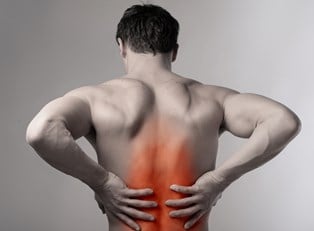Up to 80% of Americans will experience back pain at least once in their lifetime, and there are more than 3 million cases of back pain each year in the United States alone. Back pain is not a condition in itself, but rather, it's a symptom that can point to many different problems, ranging from a strained muscle to kidney trouble. Even though it can be painful to experience, it will go away without requiring surgery or other back pain treatment options in over 90% of cases.
Back Pain Symptoms
Signs and symptoms of back pain can include:
- Shooting or stabbing pain
- Pain that radiates down your leg
- Limited range of motion or flexibility of the back
- Muscle ache
Although most cases of back pain will improve on their own within a few weeks, there are rare cases when back pain could be caused by a serious medical problem that requires emergency care immediately. If you are experiencing fever, bowel or bladder problems, unexplained weight loss, or if your back pain follows an injury, see your doctor as soon as possible.
Additionally, if your back pain spreads down one or both legs (especially below the knee), causes numbness or tingling in one or both legs, or is severe and doesn’t improve with rest, this could also indicate that there is something more serious going on. For people who have a history of cancer, osteoporosis, steroid use, or drug or alcohol abuse, you should meet with your doctor to discuss your back pain and what might be causing it.
Back Pain Causes
Back pain can be caused by a number of conditions and sometimes seems to have no diagnosable cause at all. Conditions that commonly result in back pain include:
- Arthritis: The lower back is often affected by osteoarthritis. Also, sometimes arthritis can cause spinal stenosis, which is a narrowing of the space around the spine.
- Osteoporosis: When your bones are porous and brittle, this can cause your spine’s vertebrae to develop compression fractures that can be very painful.
- Muscle or ligament strain: One of the most common causes of back pain is a strained muscle or ligament. This can be caused by repeated heavy lifting, a sudden awkward movement, or simply by too much movement.
- Skeletal irregularities: If your spine is curved abnormally, this can cause pain in your back. Scoliosis is a condition in which your spine is curved to the side, but this will usually only cause back pain in severe cases.
- Bulging or ruptured discs: Also a very common cause of back pain, the discs that cushion the area between vertebrae can bulge or rupture, which can be very painful.
Back Pain Treatment Options
Usually, acute back pain improves within a few weeks of rest and self-treatment at home. However, chronic or persistent back pain may require medication or other treatment options as recommended by your doctor.
The most common way to treat back pain is through the use of medications, ranging from over-the-counter pain relievers to muscle relaxants, or in some instances, narcotics. Other cases of chronic back pain may require treatment options that include physical therapy or even surgery depending on the severity and cause of the pain.




